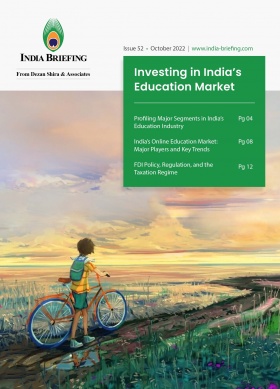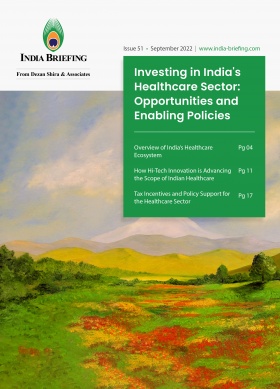Business Opportunities in the Indian Solar Energy Sector
As India announced its first 100 percent solar powered village at Modhera in Gujarat in October, we explore emerging business opportunities in the country’s solar sector. India offers immense potential for renewable energy generation due to its geographical location, supportive government policies, and 100 percent foreign direct investment (FDI) permitted under the automatic route.
On October 9, 2022, India announced Modhera village in the western state of Gujarat as the country’s first 24×7 solar-powered village. Modhera residents can save around 60-100 percent on their electricity bills with this move. The project was built at an investment of over INR 800 million, funded by federal and state government channels and in two phases.
How does Modhera’s solar model work?
Modhera village has a ground-mounted solar power plant and over 1,300 rooftop solar systems with one kilowatt (kW) capacity have been installed on houses to generate electricity. These rooftop solar systems on residential and government buildings have also been integrated with a battery energy storage system (BESS).
The village’s solar power model has improved business prospects for local residents and enabled them to sell excess unconsumed electricity to the government, thereby creating opportunities for earning additional income.
Solar power deployment in India
India is currently ranked fifth globally in total solar power deployment. The country also has a vast solar potential of 749 gigawatt (GW) for power generation primarily due to its geographical location in the sunbelt, that is the area within 35 degrees around the equator.
India plans to reach 450 GW of installed renewable energy capacity by 2030, with 280 GW (over 60 percent) expected from solar power. From April till December 2021, India added 7.4 GW of solar power capacity, up 335 percent from 1.73 GW in the previous fiscal. Furthermore, according to Mercom India Research, solar capacity installations in India rose by 59 percent to record 7.2 GW during first half (H1) of 2022, witnessing the highest ever quarterly and half-yearly solar capacity additions.
In H1 2022, Rajasthan and Gujarat emerged as top states in terms of large-scale solar installations, accounting for 53 percent and 14 percent of installations, respectively, followed by Maharashtra with 9 percent.
This was accomplished despite mounting challenges from supply constraints and rising costs. As per reports, project costs have been escalating for eight straight quarters, and have further increased post the imposition of Basic Customs Duty (BCD) on solar module and solar cell prices from April this year. In April 2021, to encourage local production, the Indian government announced a 40 percent BCD on solar modules and 25 percent on solar cells with effect from April 1, 2022.
|
Top 10 State-wise Solar Installations in India (January 2022) |
|
|
State |
Capacity megawatt (MW) |
|
Rajasthan |
10,506.95 |
|
Karnataka |
7,534.92 |
|
Gujarat |
6,309.92 |
|
Tamil Nadu |
4,894.49 |
|
Andhra Pradesh |
4,386.45 |
|
Telangana |
4,316.29 |
|
Madhya Pradesh |
2,686.60 |
|
Maharashtra |
2,603.21 |
|
Uttar Pradesh |
2,224.40 |
|
Punjab |
1,098.36 |
What are the business opportunities in the Indian solar energy sector?
|
Business Opportunities in the Solar Energy Sector in India |
||
|
Category |
Description |
|
|
Solar EPC (engineering, procurement, and construction) or installation |
Solar EPC companies obtain the necessary solar materials from a manufacturer, perform engineering work, and provide customers with installation and after-installation services. Solar knowledge and solar product knowledge along with a great network is what are of utmost importance to establishing an EPC business in the solar industry. This business might require less investment but requires more skilled workers, a network and an experienced team.
|
|
|---|---|---|
|
Manufacturing core production |
Polysilicon |
Refining sand to obtain silica |
|
Ingot |
Quartz/graphite/ceramic crucible, carbon felt and seed crystal |
|
|
Wafers |
Saw wire, sulphuric/hydrochloric acid, green/black/recycled si-carbide |
|
|
|
Crystalline (mono/poly), thin film(CDTE,GAAS,CIGS,A-SI), CPV, al-ag paste, isopropyl alcohol, ammonia, phosphorous oxychloride, sulphuric acid, hydrochloric acid, potassium hydroxide, sodium hydroxide, silane |
|
|
CPV |
Chemical salt preparation, efficiency improvement |
|
|
Crystalline module |
EVA layer, low iron glass, aluminum, PVF (tedlar), lead/copper/tin coated copper ribbon, copper wires |
|
|
Thin film module |
Ultra-clear pattern/TCO coated/AR coated glass, boron, cadmium sulphide, alumina, gallium, germanium, indium, molybdenum, phosphorous oxychloride, tellurium, tin, diethyl zinc, zinc oxide, tin oxide, hydrochloric/sulphuric acid |
|
|
Manufacturing solar Balance-of-System (BoS) for utility grid |
Rooftop/ off-grid |
Inverters, UPS, DC appliances |
|
Storage systems |
Battery manufacturing, charging control |
|
|
Tracking system |
Single axis, dual axis tracking |
|
|
Power system |
Wires, cables, junction boxes, lightning arresters, earthing systems, transformer, earthing equipment, insulators, net metering, circuit breakers, capacitors, switchgears |
|
|
Synchronizers |
Phase, phase sequence, voltage, frequency |
|
|
Cell work structures |
Poles, housings, mounting structures, nuts and bolts, etc. |
|
|
Manufacturing products |
Lighting/lanterns/street lighting/LED lighting |
|
|
Solar water pumps |
||
|
Air heating/ space |
||
|
Heating/dryers |
||
|
Solar cookers |
||
|
Telecommunication power solutions |
||
|
FPC collector/ETC tube water heaters, parabolic troughs |
||
|
BIPV systems |
||
|
Manufacturing of machinery |
Ingot |
Lifetime analyzer, vision inspector, resistivity inspector, material property analyzer, polysilicon tester, ingot cutting, grinding, MCZ process, DSS process, CZ equipment, ingot transportation and storage, granular feeder, acid water neutralization cell |
|
Wafer |
Cutting, saws, ultrasonic cleaner, inspectors and analyzers, sorter, counter, tester, grinder/polisher, water loading, water separation |
|
|
Cells |
Laser/plasma/wet etching, liquid gas flow management, drying/firing furnace, cell sorter, inspector, conveyor |
|
|
Crystalline modules |
Inspecting/ cleaning/ tabbing, stringing, framing, flux furnace |
|
|
Thin film module |
Plasma etching, cleaning, scribing, coating |
|
|
Testing equipment |
HV test, full load test (resistive load), heat run (running for rated number of hours)
|
|
|
High-voltage direct current (HVDC) evacuation systems |
||
|
Manufacturing of sub-components |
Power semiconductor devices |
Diodes, IGBT, inductors, filters, choppers |
|
Inverter sub-components |
PCB, soldering, etching, flash memory data card |
|
|
Control and monitoring |
RFID reader, RFID generator, GPS, ethernet slots |
|
|
Support services for information and training |
Human resource development and recruitment training programs |
|
|
IT services like SCADA programs, PLC manufacturing (ladder programming), forecast tools, six-sigma manufacturing, digital energy meters, microprocessor programming |
||
|
Operation and maintenance support |
||
|
Implementation support |
EPCs, site analysis, real estate- land acquisition |
|
|
Technical advisor, engineering drawing and documentation |
||
|
Policy advisors |
||
|
System integrators |
||
|
R&D and explorative |
||
|
Solar-biomass-wind hybrid |
||
|
Standards agencies: Specifying standards |
||
|
Research and development |
Solar wind biomass hybrid |
|
|
Standardizing agencies : Specifying standards of products, machines and designs |
||
How is the government supporting solar businesses in India?
The government has launched various initiatives to support building up India’s solar capacity and aiding adoption of solar power sources at subsidized costs. These initiatives include:
- The National Solar Mission: In order to harness India’s solar potential, the National Solar Mission was launched in 2010 with the primary target of installing 100 GW grid-connected solar power plants by the year 2022.
- One Sun One World One Grid (OSOWOG) – The One Sun One World One Grid Declaration (OSOWOG) was jointly released by Prime Minister Narendra Modi and UK Prime Minister Boris Johnson at the COP26 Climate Meet in Glasgow in November, 2021. The aim is to create regional and international interconnected green grids, and enable the sharing of renewable energy across international borders. The OSOWOG is divided into three main phases:
- First phase: The Indian grid would be connected to the grids of the Middle East, South Asia, and Southeast Asia to develop a common grid. This grid would then be used to share solar energy as per need, in addition to other renewable energy sources.
- Second phase: In this phase, the grid achieved in the functional first phase would be connected to the pool of renewable resources in Africa.
- Third phase: This phase would look at achieving true global interconnection. The idea will be to integrate as many countries as possible to create a single power grid of renewable energy. This can then be accessed by all countries.
- Rooftop solar (RTS) installation: In July 2021, to encourage RTS throughout the country, notably in rural regions, the Ministry of New and Renewable Energy (MNRE) undertook Rooftop Solar Programme Phase II, which aims to install RTS capacity of 4,000 MW in the residential sector by 2022 with a provision of subsidy.
- 100 percent FDI: Up to 100 percent of foreign direct investment has been permitted under the automatic route.
- Green Energy Corridor: This has been put in place to support the grid integration of large-scale renewable energy capacity addition.
- Subsidy to solar powered items: The MNRE is providing a 30 percent subsidy to most of the solar-powered items and has further extended its subsidy scheme to solar-powered cold storage.
- Renewable Energy Certificates (RECs): The RECs aim to provide an incentive to those who generate green power. It will provide financial aid for every unit of power generated by them.
Recent investments and capacity expansion plans
- The world’s largest floating 600 MW solar energy project will be constructed at the Omkareshwar Dam in the Khandwa district of Madhya Pradesh at the estimated cost of INR 30 billion. The project is expected to begin power generation by financial year 2023 (FY 23).
- Delhi’s Indira Gandhi International Airport (IGIA) has become the first Indian airport to run entirely on hydro and solar power. Around six percent of the airport’s electricity requirement is met from the onsite solar power plants.
- In November 2021, the government announced future plans to increase the funding under the PLI scheme for domestic solar cells and module manufacturing to INR 240 billion from the existing INR 45 billion to make India an exporting nation.
- E-commerce giant Amazon recently announced it would add 2.7 GW of clean energy capacity through several new projects as it seeks to use 100 percent renewable energy across its business by 2025. Out of the total 71 new projects, Amazon has announced its first utility-scale renewable energy projects in India — three solar farms located in Rajasthan. These include a 210 MW project to be developed by India-based developer ReNew Power, a 100 Mw project to be developed by local developer Amp Energy India, and a 110 MW project to be developed by Brookfield Renewable Partners. Combined, these solar farms have the capacity to generate 1,076,000 megawatt hours (MWh) of renewable energy per year, enough to power over 360,000 average-sized households in New Delhi annually.
- In September 2022, Adani Green commissioned the world’s largest 600 MW wind-solar plant In Jaisalmer. The project, consisting of 600 MW solar and 150 MW wind plants, hopes to reduce intermittency of renewable energy power and achieve optimal utilization of the transmission network.
Israel, India, the United States, and the United Arab Emirates (I2U2) group
In July 2022 , leaders from I2U2 group stated that they will advance a hybrid renewable energy project in Gujarat consisting of 300 MW of wind and solar capacity complemented by a battery energy storage system.
International Solar Alliance
The International Solar Alliance (ISA), headquartered at Gurugram, India, aims to install 1,000 GW of solar energy by 2030. Their objectives include making solar energy available at affordable rates, establishing solar credit mechanisms, reducing the cost of finance and cost of technology, and enhancing energy security.
ISA has launched five programs where solar technologies can be applied while reducing risks and addressing the financial crisis faced by the developing and least-developed states while adopting green power.
ISA’s primary target is to mobilize US$1 trillion low-cost financing for the deployment of solar energy by 2030 and bring together 121 countries under the same roof that lie between Tropics of Cancer and Capricorn.
About Us
India Briefing is produced by Dezan Shira & Associates. The firm assists foreign investors throughout Asia from offices across the world, including in Delhi and Mumbai. Readers may write to india@dezshira.com for more support on doing business in in India.
We also maintain offices or have alliance partners assisting foreign investors in Indonesia, Singapore, Vietnam, Philippines, Malaysia, Thailand, Italy, Germany, and the United States, in addition to practices in Bangladesh and Russia.
- Previous Article Profiling the Indian SaaS Landscape – A US$1 Trillion Opportunity for Businesses
- Next Article India’s OTT Media Services Industry: Rapid Growth Amid Competition for Market Share









